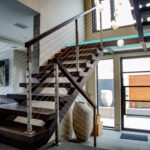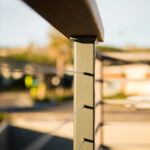Understanding Layout and Specifications for Successful Cable Tensioning
Post spans are a key component to understanding tension loads- Understanding cable railing tension is not all about special tools, sphere tests or tension gauges. All of these things are important but cable tension can be as simple as understanding proper post and cable spacing. Stainless steel cables are “elastic” in nature when compared to a solid steel pipe or vertical picket. Meaning that the cables have the potential to deflect under some weight or applied force; they aren’t designed to be rigid. Deflection is ok; when it comes to code compliance the key is not allowing deflection past a certain point. When it comes to cable railing inspections the clear spacing in between two cables must not deflect to a point that will allow a 4″ sphere to pass through the infill. Tighter post spacing = tighter cables with less effort.
Types of posts matter – End posts and corner posts are the most load bearing members involved in a cable railing frame. Think about end posts like an anchor point that is being pulled on. Sturdy posts made from heavy timber, steel or stainless steel will create the strongest anchors. Aluminum frames and undersized wood timbers can function well but they will require tighter spacing to achieve proper tension. Choosing an engineered cable railing system and following the specifications provided by the manufacturer can be one of the easiest ways to ensure success. An “engineered” railing post has been designed and tested to sustain tension loads and provide a solid connection to the deck surface.
Different specs for different systems- If we take a close look at the variation in specifications from different manufacturers we will usually find that aluminum railings have more supplementary posts (spreaders or pickets) and that the post members will be spaced closer together. The reason for this is that in most cases the aluminum end posts cannot sustain as much load as the steel or heavy timber end posts; therefore the posts must be spaced tighter to limit deflection. Many times these aluminum railing systems will use a top and bottom rail; limiting the number of cables by adding a solid support. Our favorite aluminum railings for both cable and glass railings are Feeney Design-rail systems. Feeney railings are engineered and proven throughout the industry on large commercial railing projects like apartment buildings and commercial spaces.
Engineered railings are the safe choice– As railing installers we focus on following manufacturer recommendations; our job is not to hyper focus on numbers and calculation details that are already tested by the manufacturers. We focus on using proven systems and following the recommended layouts and spacing. Additional efforts are made to use the proper connections and backing requirements. We have passed railing inspections at 150lbs of tension with the right post and cable spacing, as well as solid connections. Too many internet articles about cable tension confuse novice installers and DIYers with framing safety factors and huge numbers like 300 pounds per cable that can encourage people to apply too much tension. Our ultimate goal is achieving just enough tension to prevent a 4″ sphere test; keeping our pets and children safe without damage to the railing system.
If you have questions about cable tension or would like a quote on an engineered railing system give us a call at 844-277-7327 or visit the quote request page.




